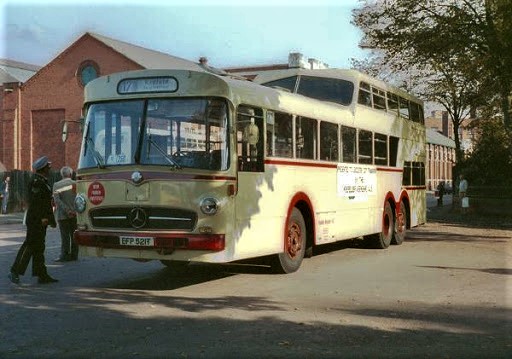The History
Krefelder Verkehrs AG 7105 is a German one and a half decker urban bus (German – Eineinhalbdecker or Anderthalbdecker), a formerly common design in West Germany which presents a strong contrast with Aberdeen/British practice.
There has been a trend for a long time in public transport to maximise the numbers of passengers carried within the legal limits on vehicle length. The situation in West Germany was no different but there it was recognised in the early 1950s that if more passengers were to be carried on a single vehicle, then serious thought had to be given as to how passenger’s fares were to be collected. Two approaches were widely adopted:
1. simplification of fares structures plus encouragement of ticket sales to passengers off the vehicle to minimise delays at bus stops and to ease the work of conductors,
2. use of vehicles with a large standing area at the rear where passengers had to get on board -passengers then filed past a seated conductor who took the fares/checked tickets, eventually alighting from doors toward the front (a “passenger flow” system).
Two common types of large motorbus evolved in West Germany - the “one and a half decker” and the articulated single decker (see GRT Ltd 1). The “one and a half decker” was originally developed as a touring coach bodywork form in the late 1940s by the firm of Ludewig of Essen, their concept being further developed in the 1950s for high passenger capacity urban buses, usually on three axle chassis. In common with British practice, Ludewig would fit their bodywork to the chassis of any manufacturer, the framework of these bodies being steel. However, in contrast to British practice the exterior panelling was also steel, not aluminium. The unladen weight of 7105 is about 11½ tons, very heavy by British standards at this time, but it could take 146 passengers, 93 of them standing. The low bridge form of upper deck seating with side gangway allowed an extra 21 seats to be accommodated without sacrificing standing area and kept the height of the vehicle low.
The chassis used on 7105 is the Mercedes-Benz O317, a horizontal underfloor engined single decker which has had the chassis extended and a third, unpowered, axle added. It has a manual (synchromesh) gearbox and air brakes.
7105 was owned by Krefeld from 1965 to 1978 when it was presented to Krefeld’s twin town of Leicester, acquiring the UK registration EFP521T. By this time the bus had been modified for driver only operation whereby the front and rear door widths were changed, and some seating was added on the former back platform. Subsequent to Leicester’s municipal bus operation becoming part of the Grampian Transport Holdings group, 7105 came to Aberdeen and eventually into the care of the Trust.
"Krefelder Verkehrs-AG"
A Daimler-Benz O317 with Ludewig one and a half deck body, new in 1966 and presented to Leicester in 1978 by its twin town of Krefeld in Germany. It then acquired the UK registration EFP521T. The same year in return, Krefeld received Leicester 85, a 1964 Leyland double decker with East Lancs body.
The sign on the side of the bus reads "Presented to Leicester City Transport by the Krefelder Verkehrs A.G."
The bus was moved to Aire, Scotland when Grampian Bus Company took over Leicester City Bus in the mid-1990s. Since then the annually published list for preserved buses show that it is now owned by Hills of Aberdeen.
Hersteller Daimler-Benz
Typ O 317 Fahrgestell
Fahrgestellnummer 317.231-10-005557
Baujahr des Fahrgestells 1972
Erstzulassung 24.1.1974 - KR-ZD 55
Zulassung E-O 317H
Aufbauten Ludewig AERO-Anderthalbdecker-Aufbau.
1 einfach breite und 2 doppelt breite Türen (VMh).
Länge 12.000 mm
Breite 2430 mm
Höhe 3750 mm
Radabstand 5250/1300 mm
Leistung 136 kW
Ges.gewicht 14 t
Plätze 154
davon Sitzpl. 47+1 [im Gelegenheitsverkehr nur Sitzplätze]
Ausstattung Teeküche mit Kühlschrank und Kaffeemaschine, Musikanlage mit Mikrofon, 230V-Anschluss (bei stehendem Fahrzeug)
„Lebenslauf“ 1974 Linieneinsatz bei der Krefelder Verkehrs-AG als Wagen 5555
1984 Einsatz als Fahrschulwagen beim TÜV Rheinland in Krefeld (LKW-Zulassung)
1986 Übernahme durch einen Privatmann, anschl. „Dornröschenschlaf“
1996 Endeckung durch Mitglieder der VHAG, Übernahme durch die EVAG, anschl. Aufarbeitung durch die EVAG, die Firma Lingner und andere.
2003 Fertigstellung und Einsatz als Museumsbus unter der Nummer 3902

